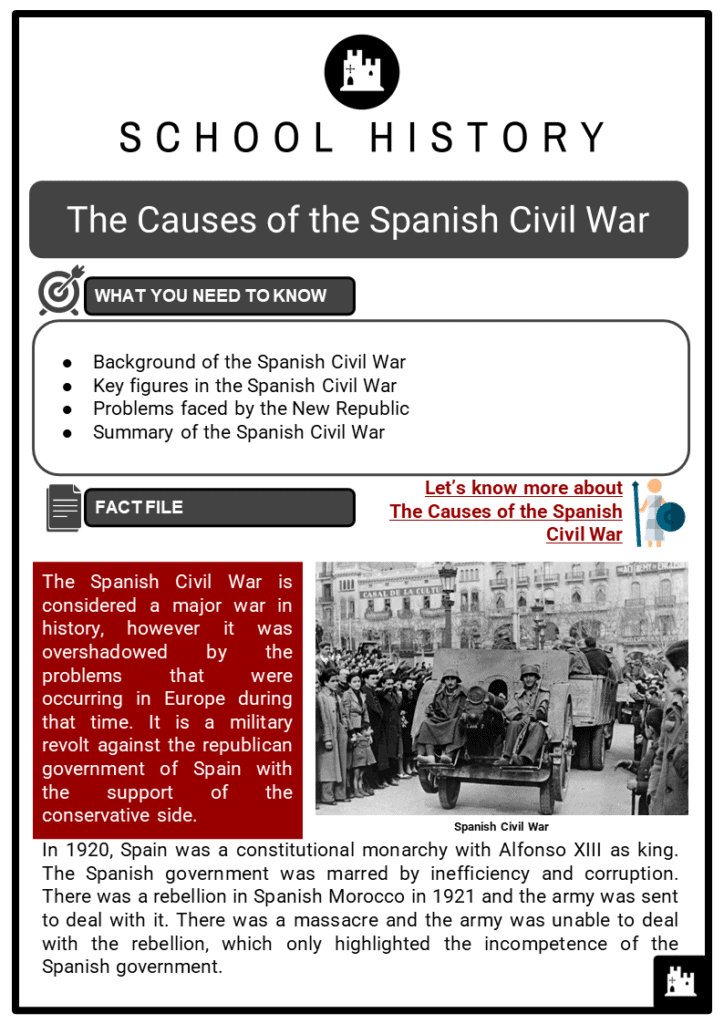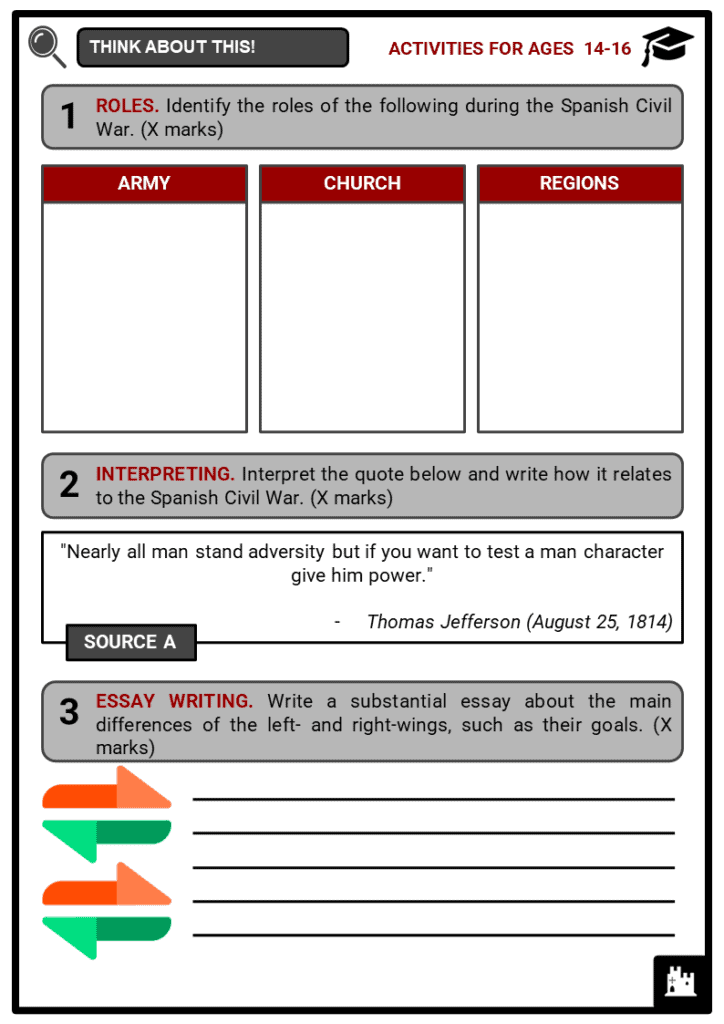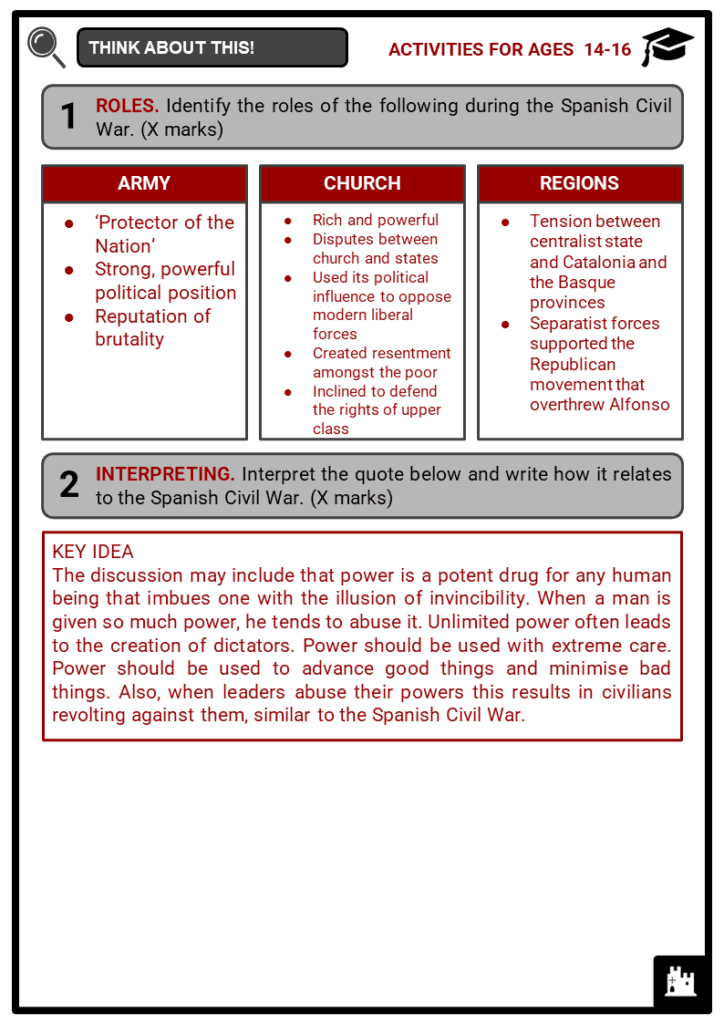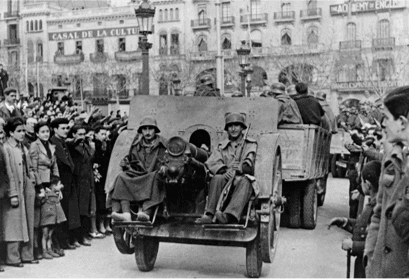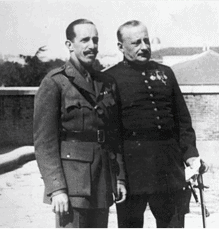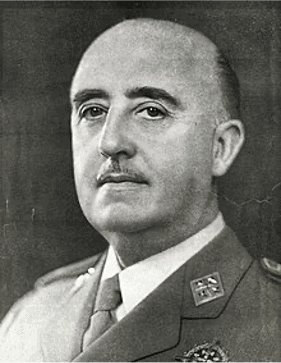Download The Causes of the Spanish Civil War Worksheets
Do you want to save dozens of hours in time? Get your evenings and weekends back? Be able to teach The Causes of the Spanish Civil War to your students?
Our worksheet bundle includes a fact file and printable worksheets and student activities. Perfect for both the classroom and homeschooling!
Table of Contents
Add a header to begin generating the table of contents
Summary
- Background of the Spanish Civil War
- Key figures in the Spanish Civil War
- Problems faced by the New Republic
- Summary of the Spanish Civil War
Key Facts And Information
Let’s know more about The Causes of the Spanish Civil War
- The Spanish Civil War is considered a major war in history, however it was overshadowed by the problems that were occurring in Europe during that time. It is a military revolt against the republican government of Spain with the support of the conservative side.
- In 1920, Spain was a constitutional monarchy with Alfonso XIII as king. The Spanish government was marred by inefficiency and corruption. There was a rebellion in Spanish Morocco in 1921 and the army was sent to deal with it. There was a massacre and the army was unable to deal with the rebellion, which only highlighted the incompetence of the Spanish government.
- In 1923, a bloodless coup was experienced in Spain and the leader of the army, General Primo de Rivera, took over from King Alfonso XIII. He used the military to rule as a dictator until 1930. It is worth noting that Rivera’s style of leadership was fully supported by the previous leader, Alfonso.
- Rivera, however, did not exhibit the classic signs of a dictator.
- There was the introduction of public work schemes and there was the building of roads and irrigation plants in the country.
- Industrial production in the country increased threefold between 1923 and 1930.
- Rivera also successfully quashed a rebellion in Morocco in 1925.
- The Great Depression of the 1930s soon followed and Spain was hit hard by it. Employment plummeted and General Rivera was not capable of sorting out Spain’s financial mess. The army’s support was soon withdrawn and Rivera’s resignation followed shortly after.
- Elections were held in April 1931, and the Republicans won in all the major cities in Spain. Alfonso decided to abdicate as he feared that if he did not Spain would crumble. The victors declared Spain a republic and the monarchy was done away with. The newly formed republic immediately encountered a number of major problems.
Problems Faced By The New Republic
- Two of the most important regions in Spain, Catalonia and Basque, wanted to gain their independence. This would have led to Spain being broken up. There was a newly formed rivalry between the Roman Catholic Church and the republic, and they were very hostile towards each other. The Roman Catholic Church had a high standing in the country and was very influential.
- In addition to this, the government realised that the army had too much of a say in politics and was determined to reduce its power and influence.
- The little industrialisation that Spain had been experiencing was also hit by the Depression. Iron and steel were hit badly because no one had the money to pay for the products. Iron production reduced by 33% and steel by 50%.
- Unemployment soon hit the agricultural, steel and iron industries and those who worked there had to get subsidised wages to survive the Depression.
- The republic faced losing the support of the working class and they desperately needed this.
- Those who were at the helm of the Spanish government had differing views on what to do.
- The wishes of some of them alarmed those on the other side and vice versa.
- Political infighting had started and there was a risk of pushing Spain into a social revolution and plunging it into chaos.
- The socialists and middle-class radicals, the middle ground in Spain’s parliament, tried to resolve these outstanding problems.
- Catalonia received some element of self-governance. The privileges of the Roman Catholic Church were attacked and the priests were no longer paid by the state but their salaries now came from the Roman Catholic Churches. The government and the Roman Catholic Church were now two separate entities.
- Huge estates in Spain were nationalised, which means the government took over and would control what was done on them. The wages of those who worked in industries were increased, however they were to be paid by the owners of those industries and not by the government.
- The government, in short, tried to attack those it perceived as enjoying too many privileges in society, and by doing this it antagonised all those sectors in society that had the potential to revolt – that is the military, landowners, the Roman Catholic Church, and the industrialists.
- These four, which were potentially the most powerful bodies, were unwilling to support the republican government in the capital of Spain, Madrid.
- They were also made aware of countries in Europe that would be willing to give support to their cause as they were scared of communist Russia under Stalin.
- Mussolini, the head of fascist Italy, would be an obvious ally and also the Germans once Hitler had risen to power in January 1933.
- A number of army officers tried to overthrow the government in January 1932. Led by the prime minister, Manuel Azana I, they proved unsuccessful as the army was momentarily loyal to the government as the government was legitimate and had won the elections. A new political party was being formed, however, called the Ceda. It was a right-wing party that vowed to protect the authority of the Roman Catholic Church and the disgruntled landlords.
- The government of Azana lost support from the right-wing party. Two powerful left-wing political parties, the syndicalists and the anarchists, and two powerful trade union entities thought that Azana’s government was too conservative. They both sought a more communist state and wanted to overthrow capitalism.
- Azana was also hated for forming a political union with the middle ground in Spain’s political life. This was seen as a betrayal by the working class. They organised strikes and riots in an effort to shake the government of Azana.
- Matters got out of hand when, in January 1933, 25 people were killed by government troops. They were attempting to catch some anarchists near Cadiz. This cost the government major support from the working class and the socialists. Azana resigned as prime minister and elections were held in November 1933. The right-wing party won this election and the majority of support was for the largest party in the parliament, called the Cortes, and the Ceda led by Gil Robles.
- The new right-wing government immediately over-turned all of the changes brought in by the Azana government. This angered many but especially the Catalans who had their privileges withdrawn. This was a serious error of judgement as the Catalans and Basques had supported the government in the elections. The way ahead for Robles became clear to many – an attack on the left-wing parties of Spain.
- Consequently, parties of the left came together to form the Popular Front.
- They organised riots and strikes and took part in acts of violence such as removing mainline train tracks.
- There was a general strike in 1934 and coal miners in the Asturias went on strike, though they were not heard and were put down by the army General, General Franco. Spain appeared to be heading for more chaos but in a last-minute effort to avoid serious trouble, a general election was called in February 1936.
- The Popular Front won and Azana once again became the prime minister.
- The government of the Popular Front was in disarray when the socialists withdrew their support. More and more public protests occurred and the government had clearly lost control of Spain. A leading right-wing politician, Sotelo, was killed in July 1936 and right-wing politicians and their supporters believed that they were now in mortal danger. They wanted to place their faith in a military dictatorship.
- The military had already put in place preparations for a takeover of Spain under General Franco. He overthrew the civilian government and took control of Spanish Morocco. His next target was to infiltrate mainland Spain, establish a military government there and do away with all those involved in left-wing politics. The left-wing would have to fight for survival. The civil war started in July 1936.
Summary Of The Spanish Civil War
- On 17 July 1936, the Spanish army led by General Franco started the Spanish Civil War by rebelling against the Second Republic. The main objective of the rebellion was the destruction of left-wing organisations.
- Franco’s fellow rank, General Queipo de Llano, instructed his juniors on how to deal with the ‘Bolshevik’ activists with this chilling order: They were to use extreme force and were authorised to kill. Such attitudes made the war a terrible tragedy before it ended in April 1939. Over 325,000 died in battle and from disease. An estimate of 150,000 were executed Francoists.
Image sources:

